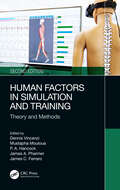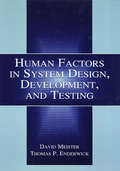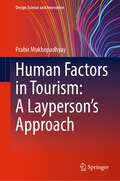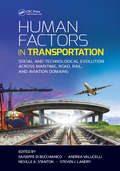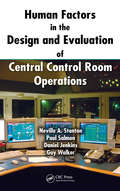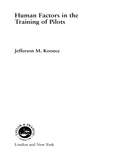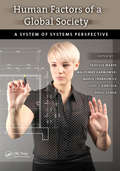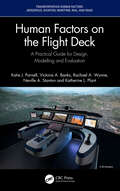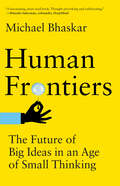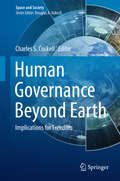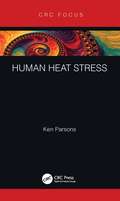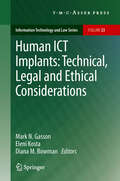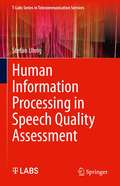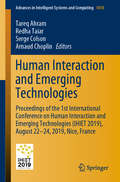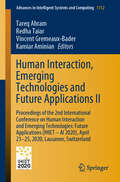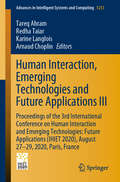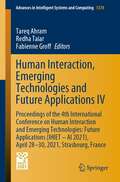- Table View
- List View
Human Factors in Simulation and Training: Theory and Methods
by Dennis Vincenzi, Mustapha Mouloua, P. A. Hancock, James A. Pharmer, and James C. FerraroHuman Factors in Simulation and Training: Theory and Methods covers theoretical concepts on human factors principles as they apply to the fields of simulation and training in the real world. This book discusses traditional and nontraditional aspects of simulation and training. Topics covered include simulation fidelity, transfer of training, limits of simulation and training, virtual reality in the training environment, simulation-based situation awareness training, automated performance measures, performance assessment in simulation, adaptive simulation-based training, and scoring simulations with artificial intelligence This book will be a valuable resource for professionals and graduate students in the fields of ergonomics, human factors, computer engineering, aerospace engineering and occupational health and safety.
Human Factors in System Design, Development, and Testing (Human Factors And Ergonomics Ser.)
by David Meister Thomas P. EnderwickHuman Factors in System Design, Development, and Testing describes engineering system design as a behavioral process, a process which raises questions the designer must answer. It focuses on the concepts underlying the design process, culminating in a behavioral theory of the design process. Special effort has been made to depict human facto
Human Factors in Tourism: A Layperson's Approach (Design Science and Innovation)
by Prabir MukhopadhyayThe textbook covers the application of human factors in different facets of tourism and hospitality industry. It talks about appropriate ambience creation for guests, so they can enjoy their stay. This book enumerates different human factors aspects of dealing with tourists, conducting guided tours, or ensuring that tourists are completely satisfied from the tour in detail but in a layperson’s language. This book discusses details of the application of human factors in the tourism sector. This book aims to fill the gap between the literature available on tourism that deals with people and human factors that deals with the interaction among people, space, and products. This book aids the students and instructors in understanding and teaching different human factors issues in this sector. Further, this book will help professionals in the industry in providing quality services to their clients.
Human Factors in Transportation: Social and Technological Evolution Across Maritime, Road, Rail, and Aviation Domains (Industrial and Systems Engineering Series)
by GIUSEPPE DI BUCCHIANICO, ANDREA VALLICELLI, NEVILLE A. STANTON AND STEVEN J. LANDRYMore and more the most traditional and typical applied ergonomics issues of the activities related to sea shipping, vehicle driving, and flying are required to deal with some emerging topics related to the growing automatism and manning reduction, the ICT’s advances and pervasiveness, and the new demographic and social phenomena, such as aging or multiculturalism. With contributions from expert researchers, professionals, and doctoral students from a wide number of countries such as Australia, Austria, Canada, Italy, Germany, the Netherlands, Norway, Sweden, UK and USA, this multi-contributed book will explore traditional and emerging topics of Human Factors centered around the maritime, road, rail, and aviation transportation domains.
Human Factors in der Industrie: Ein Praxisratgeber: Wie Sie mit Impulsen aus der Luftfahrt Fehler und Nacharbeit vermeiden können
by Martin Hinsch Jens OlthoffDer Alltag in Industriebetrieben ist seit Jahren geprägt von stetig zunehmender Komplexität, Informations- und Dokumentationsflut, Zwang zu intensiver Teamarbeit und ständigem Wandel der Rahmenbedingungen. Da die Luftfahrt über jahrzehntelange Erfahrung in einem solchen Umfeld verfügt, erläutert dieses Buch in leicht verständlicher Sprache praxiserprobte Konzepte und Arbeitsmethoden dieser Branche, die sich gut in die betriebliche Praxis von Industrieunternehmen übertragen lassen. Der Fokus richtet sich auf Maßnahmen im Bereich der Teaminteraktion, Kommunikation, Prozessorientierung, auf Fehlervermeidungskonzepte und die Schwächen der menschlichen Leistungsfähigkeit.Der Inhalt Luftfahrt als Impulsgeber für die Industrie.- Menschliche Grenzen kennen und beherrschen.- Das Dirty Dozen – die 12 häufigsten menschlichen Fehler.- Kommunikation und Teamwork.- Führung. - Situationsbewusstsein und Workload-Management.- Prozesse als Basis replizierbarer Spitzenleistung.- Qualifikation und Training.- Fehlerreflexion und Fehlerbewusstsein.
Human Factors in the Design and Evaluation of Central Control Room Operations
by Paul Salmon Neville A. Stanton Guy Walker Daniel JenkinsWhether used for aviation, manufacturing, oil and gas extraction, energy distribution, nuclear or fossil fuel power generation, surveillance or security, all control rooms share two common features. The people operating them are often remote from the processes that they are monitoring and controlling and the operations work 24/7. The twin demands o
Human Factors in the Maritime Domain
by Tim Horberry Michelle Grech Thomas KoesterThe piecemeal fashion in which human factors research has been conducted in the maritime domain makes information retrieval available only by scanning through numerous research journals and conference papers. Bringing together human factors information from this and other domains, Human Factors in the Maritime Domain integrates a common body of knowledge into one single volume. The book provides the vital background information necessary to acquire a core knowledge base and a much-needed overview of human factors within the maritime domain. It starts by putting the topic into an historical and theoretical context, moves onto more specific and detailed topics and contemporary thinking in human factors, then reviews new maritime technology. The authors take a holistic approach based on a model of the socio-technical system of work in the maritime domain. They synthesize available knowledge and research, then present in an easily acceptable framework with example, illustrations, and case studies whenever possible, making the text rigorous, useful, and enjoyable. The three authors draw on a range of diverse backgrounds including working as a maritime surveyor, transport consultant, human factors lecturer, and mechanical engineer. They have undertaken maritime research in Denmark, Australia, Malta, and the UK. They have published several other human factor books on related topics. This combination of human factors knowledge, maritime wisdom, and substantial publication experience results in a book that is effective and practical.
Human Factors in the Training of Pilots
by Jefferson M. KoonceIn this educational yet entertaining text, Jeff Koonce draws on his 44 years of pilot experience and 31 years as a professor of psychology and human factors engineering in addressing the questions of how to apply sound human factors principles to the training of pilots and to one's personal flying. The author discusses principles of human f
Human Factors in the U.S. Railroad Industry (Transportation Human Factors)
by Thomas G. RaslearAt the heart of the U.S. Railroad Industry are human operators who continue to make it work and operate. However, humans are susceptible to error, fatigue, and risky behaviors. Understanding how these impact the safety of the industry remains a crucial topic to be studied. Human Factors in the U.S. Railroad Industry investigates the human factor behind one of the world’s biggest railway networks and synthesizes the body of research that has been produced by the Federal Railroad Administration (FRA) on Human Factors in the Railroad industry since 1993.During that time, over 120 FRA reports were published on topics such as accident analysis, grade crossing safety and trespassing, working conditions and ergonomics, employee fatigue, safety culture, and track inspection. This book organizes this body of work into topic areas that correspond to Moray’s Sociotechnical System (2006) to provide a comprehensive way to understand the relationship between policy, organizational culture, and system safety. It discusses tools such as risk exposure, signal detection theory, and program evaluation that have been applied to railroad projects and can be used to improve future railroad and transportation research. It provides a synthesis of the reports across topic areas such as fatigue, ergonomics, and safety culture that are currently important within the wider human factors transportation research community. The reader will develop an understanding of a “human-centered systems” approach to the railroad industry, which focuses on human capabilities and limitations with respect to human/system interfaces, operations, system integration, and organizational influences on safety.Human Factors in the U.S. Railroad Industry will appeal to researchers, academics, students, and professionals interested in human factors, railway engineering, civil engineering, and industrial engineering.
Human Factors of Visual and Cognitive Performance in Driving
by Candida CastroWritten clearly and concisely, using jargon-free language that is easily understood, this book compresses research from the past few decades into an accessible resource. It focuses on the concrete cognitive processes of driving, specifically, information acquisition and information processing. The authors delineate the theory, practice, and application of human factors knowledge and psychology to explain human errors that occur when acquiring information from the road environment. The book provides content on highway engineering, new technologies, vehicle, signage, VMS, and safety as well as information about the human factors on errors, situation awareness, workload, and fatigue.
Human Factors of a Global Society: A System of Systems Perspective (Ergonomics Design & Mgmt. Theory & Applications)
by Waldemar Karwowski Jussi Kantola Pavel Zgaga Tadeusz Marek Marek FrankowiczDuring the last 60 years the discipline of human factors (HF) has evolved alongside progress in engineering, technology, and business. Contemporary HF is clearly shifting towards addressing the human-centered design paradigm for much larger and complex societal systems, the effectiveness of which is affected by recent advances in engineering, scien
Human Factors on the Flight Deck
by Joachim Scheiderer Hans-Joachim EbermannWhat is for a professional pilot required to fly as safe as possible? Written by pilots the book gives a detailed introduction into the basics of accident prevention in air traffic. Explicit background knowledge as well as detailed listings of safety relevant features in human behaviour are included.
Human Factors on the Flight Deck: A Practical Guide for Design, Modelling and Evaluation (Transportation Human Factors)
by Neville A. Stanton Katie J. Parnell Katherine L. Plant Victoria A. Banks Rachael A. WynneThis book presents the Human Factors methodologies and applications thereof that can be utilised across the design, modelling and evaluation stages of the design lifecycle of new technologies entering future commercial aircraft. As advances are made to the architecture of commercial aircraft cockpits, Human Factors on the Flight Deck argues that it is vitally important that these new interfaces are safely incorporated and designed in a way that is usable to the pilot. Incorporation of Human Factors is essential to ensuring that engineering developments to avionic systems are integrated such that pilots can maintain safe interactions while gaining information of value. Case study examples of various technological advancements during their early conceptual stages are given throughout to highlight how the methods and processes can be applied across each stage. The text will be useful for professionals, graduate students and academic researchers in the fields of aviation, Human Factors and ergonomics.
Human Friendly Robotics: 10th International Workshop (Springer Proceedings in Advanced Robotics #7)
by Fanny Ficuciello Fabio Ruggiero Alberto FinziThe International Workshop on Human-Friendly Robotics (HFR) is an annual meeting that brings together academic scientists, researchers and research scholars to exchange and share their experiences and research results on all aspects related to the introduction of robots into everyday life. HFR collects contributions on current developments of a new generation of human-friendly robots, i.e., safe and dependable machines, operating in the close vicinity to humans or directly interacting with them in a wide range of domains. The papers contained in the book describe the newest and most original achievements in the field of human-robot-interaction coming from the work and ideas of young researchers. The contributions cover a wide range of topics related to human-robot interaction, both physical and cognitive, including theories, methodologies, technologies, empirical and experimental studies.
Human Frontiers: The Future of Big Ideas in an Age of Small Thinking
by Michael BhaskarWhy has the flow of big, world-changing ideas slowed down? A provocative look at what happens next at the frontiers of human knowledge.The history of humanity is the history of big ideas that expand our frontiers—from the wheel to space flight, cave painting to the massively multiplayer game, monotheistic religion to quantum theory. And yet for the past few decades, apart from a rush of new gadgets and the explosion of digital technology, world-changing ideas have been harder to come by. Since the 1970s, big ideas have happened incrementally—recycled, focused in narrow bands of innovation. In this provocative book, Michael Bhaskar looks at why the flow of big, world-changing ideas has slowed, and what this means for the future.Bhaskar argues that the challenge at the frontiers of knowledge has arisen not because we are unimaginative and bad at realizing big ideas but because we have already pushed so far. If we compare the world of our great-great-great-grandparents to ours today, we can see how a series of transformative ideas revolutionized almost everything in just a century and a half. But recently, because of short-termism, risk aversion, and fractious decision making, we have built a cautious, unimaginative world. Bhaskar shows how we can start to expand the frontier again by thinking big—embarking on the next Universal Declaration of Human Rightsor Apollo mission—and embracing change.
Human Governance Beyond Earth
by Charles S. CockellThis book extends the discussion of the nature of freedom and what it means for a human to be free. This question has occupied the minds of thinkers since the Enlightenment. However, without exception, every one of these discussions has focused on the character of liberty on Earth. In this volume the authors explore how people are likely to be governed in space and how that will affect what sort of liberty they experience. Who will control oxygen? How will people maximise freedom of movement in a lethal environment? What sort of political and economic systems can be created in places that will be inherently isolated? These are just a few of the major questions that bear on the topic of extra-terrestrial liberty. During the last forty years an increasing number of nations have developed the capability of launching people into space. The USA, Europe, Russia, China and soon India have human space exploration programs. These developments raise the fundamental question of how are humans to be governed in space. This book follows from a previous volume published in this series which looked at the Meaning of Liberty Beyond the Earth and explored what sort of freedoms could exist in space in a very general way. This new volume focuses on systems of governance and how they will influence which of these sorts of freedoms will become dominant in extra-terrestrial society. The book targets a wide readership covers many groups including: Space policy makers interested in understanding how societies will develop in space and what the policy implications might be for space organisations. Space engineers interested in understanding how social developments in space might influence the way in which infrastructure and space settlements should be designed. Space scientists interested in how scientific developments might influence the social structures of settlements beyond the Earth. Social scientists (political philosophers, ethicists etc) interested in understanding how societies will develop in the future.
Human Hacked: My Life and Lessons as the World's First Augmented Ethical Hacker
by Len NoeDiscover the future of cybersecurity through the eyes of the world's first augmented ethical hacker In Human Hacked: My Life and Lessons as the World's First Augmented Ethical Hacker by Len Noe, a pioneering cyborg with ten microchips implanted in his body, you'll find a startlingly insightful take on the fusion of biology and technology. The author provides a groundbreaking discussion of bio-implants, cybersecurity threats, and defenses. Human Hacked offers a comprehensive guide to understanding an existing threat that is virtually unknown. How to implement personal and enterprise cybersecurity measures in an age where technology transcends human limits and any person you meet might be augmented. The book provides: Exposure of a subculture of augmented humans hiding in plain sight Explorations of the frontier of bio-Implants, showing you the latest advancements in the tech and how it paves the way for access to highly restricted technology areas Discussions of cybersecurity tactics, allowing you to gain in-depth knowledge of phishing, social engineering, MDM restrictions, endpoint management, and more to shield yourself and your organization from unseen threats A deep understanding of the legal and ethical landscape of bio-implants as it dives into the complexities of protections for augmented humans and the ethics of employing such technologies in the corporate and government sectors Whether you're a security professional in the private or government sector, or simply fascinated by the intertwining of biology and technology, Human Hacked is an indispensable resource. This book stands alone in its category, providing not just a glimpse into the life of the world's first augmented ethical hacker, but also offering actionable insights and lessons on navigating the evolving landscape of cybersecurity. Don't miss this essential read on the cutting edge of technology and security.
Human Heat Stress
by Ken ParsonsThousands of people continue to die from heat. Heat illnesses and advice for preventing heat casualties at work, during heatwaves, sport and the effects of global warming are described. A new perspective on thermoregulation integrates physiological and psychophysical regulated variables. Heat stress indices, the WBGT and the SWreq are presented. It is time to understand and routinely use computer simulations of people in hot conditions. How to understand how a model can be constructed is also described. This book provides an accessible, concise and comprehensive coverage into how people respond to heat and how to predict and avoid heat causalities. A practical productivity model, and Burn thresholds, complete the book which begins with up to date knowledge on measurement of heat stress, heat strain, metabolic rate and the thermal properties and influences of clothing. Features Provides methods and regulations through international standards Illustrates the WBGT and analytical heat stress indices and how to construct a thermal model Discusses the role of clothing on heat stress and thermal strain Presents a new model for predicting productivity in the heat Offers a new method of human thermoregulation Considers heat illness and prevention during heatwaves and in global warming
Human ICT Implants: Technical, Legal and Ethical Considerations
by Mark N. Gasson Diana M. Bowman Eleni KostaHuman information and communication technology (ICT) implants have developed for many years in a medical context. Such applications have become increasingly advanced, in some cases modifying fundamental brain function. Today, comparatively low-tech implants are being increasingly employed in non-therapeutic contexts, with applications ranging from the use of ICT implants for VIP entry into nightclubs, automated payments for goods, access to secure facilities and for those with a high risk of being kidnapped. Commercialisation and growing potential of human ICT implants have generated debate over the ethical, legal and social aspects of the technology, its products and application. Despite stakeholders calling for greater policy and legal certainty within this area, gaps have already begun to emerge between the commercial reality of human ICT implants and the current legal frameworks designed to regulate these products. This book focuses on the latest technological developments and on the legal, social and ethical implications of the use and further application of these technologies.
Human Information Processing in Speech Quality Assessment (T-Labs Series in Telecommunication Services)
by Stefan UhrigThis book provides a new multi-method, process-oriented approach towards speech quality assessment, which allows readers to examine the influence of speech transmission quality on a variety of perceptual and cognitive processes in human listeners. Fundamental concepts and methodologies surrounding the topic of process-oriented quality assessment are introduced and discussed. The book further describes a functional process model of human quality perception, which theoretically integrates results obtained in three experimental studies. This book’s conceptual ideas, empirical findings, and theoretical interpretations should be of particular interest to researchers working in the fields of Quality and Usability Engineering, Audio Engineering, Psychoacoustics, Audiology, and Psychophysiology.
Human Information Processing in Speech Quality Assessment (T-Labs Series in Telecommunication Services)
by Stefan UhrigThis updated book introduces a new process-oriented approach towards speech quality assessment. Using multiple methods, this approach allows readers to investigate the influence of speech transmission quality on perceptual and cognitive processes in human listeners. Fundamental concepts and methods related to the topic of process-oriented speech quality assessment are introduced and discussed. Moreover, a functional process model of speech quality perception is described, which theoretically integrates the results obtained in three experimental studies. This book’s conceptual ideas, empirical findings, and theoretical interpretations should be of particular interest to researchers working in the fields of Quality and Usability Engineering, Audio Engineering, Psychoacoustics, Psychophysiology, and Audiology.
Human Interaction and Emerging Technologies: Proceedings of the 1st International Conference on Human Interaction and Emerging Technologies (IHIET 2019), August 22-24, 2019, Nice, France (Advances in Intelligent Systems and Computing #1018)
by Tareq Ahram Redha Taiar Serge Colson Arnaud ChoplinThis book reports on research and developments in human-technology interaction. A special emphasis is given to human-computer interaction, and its implementation for a wide range of purposes such as healthcare, aerospace, telecommunication, and education, among others. The human aspects are analyzed in detail. Timely studies on human-centered design, wearable technologies, social and affective computing, augmented, virtual and mixed reality simulation, human rehabilitation and biomechanics represent the core of the book. Emerging technology applications in business, security, and infrastructure are also critically examined, thus offering a timely, scientifically-grounded, but also professionally-oriented snapshot of the current state of the field. The book is based on contributions presented at the 1st International Conference on Human Interaction and Emerging Technologies, IHIET 2019, held on August 22-24, in Nice, France. It offers a timely survey and a practice-oriented reference guide to systems engineers, psychologists, sport scientists, physical therapists, as well as decision-makers, designing or dealing with the new generation of service systems.User Experience of a Social Media Based Knowledge Sharing System in Industry Work, Chapter of this book is available open access under a CC BY 4.0 license at link.springer.com
Human Interaction, Emerging Technologies and Future Applications II: Proceedings of the 2nd International Conference on Human Interaction and Emerging Technologies: Future Applications (IHIET – AI 2020), April 23-25, 2020, Lausanne, Switzerland (Advances in Intelligent Systems and Computing #1152)
by Tareq Ahram Redha Taiar Vincent Gremeaux-Bader Kamiar AminianThis book reports on research and developments in human-technology interaction. A special emphasis is given to human-computer interaction, and its implementation for a wide range of purposes such as healthcare, aerospace, telecommunication, and education, among others. The human aspects are analyzed in detail. Timely studies on human-centered design, wearable technologies, social and affective computing, augmented, virtual and mixed reality simulation, human rehabilitation and biomechanics represent the core of the book. Emerging technology applications in business, security, and infrastructure are also critically examined, thus offering a timely, scientifically-grounded, but also professionally-oriented snapshot of the current state of the field. The book is based on contributions presented at the 2nd International Conference on Human Interaction and Emerging Technologies: Future Applications, IHIET-AI 2020, held on April 23-25, in Lausanne, Switzerland. It offers a timely survey and a practice-oriented reference guide to researchers and professionals dealing with design and/or management of the new generation of service systems.
Human Interaction, Emerging Technologies and Future Applications III: Proceedings of the 3rd International Conference on Human Interaction and Emerging Technologies: Future Applications (IHIET 2020), August 27-29, 2020, Paris, France (Advances in Intelligent Systems and Computing #1253)
by Tareq Ahram Redha Taiar Arnaud Choplin Karine LangloisThis book reports on research and developments in human-technology interaction. A special emphasis is given to human-computer interaction, and its implementation for a wide range of purposes such as healthcare, aerospace, telecommunication, and education, among others. The human aspects are analyzed in detail. Timely studies on human-centered design, wearable technologies, social and affective computing, augmented, virtual and mixed reality simulation, human rehabilitation and biomechanics represent the core of the book. Emerging technology applications in business, security, and infrastructure are also critically examined, thus offering a timely, scientifically-grounded, but also professionally-oriented snapshot of the current state of the field. The book is based on contributions presented at the 3rd International Conference on Human Interaction and Emerging Technologies: Future Applications, IHIET 2020, held on August 27-29, 2020. It offers a timely survey and a practice-oriented reference guide to researchers and professionals dealing with design and/or management of the new generation of service systems.
Human Interaction, Emerging Technologies and Future Applications IV: Proceedings of the 4th International Conference on Human Interaction and Emerging Technologies: Future Applications (IHIET – AI 2021), April 28-30, 2021, Strasbourg, France (Advances in Intelligent Systems and Computing #1378)
by Tareq Ahram Redha Taiar Fabienne GroffThis book reports on research and developments in human-technology interaction. A special emphasis is given to human-computer interaction, and its implementation for a wide range of purposes such as healthcare, manufacturing, transportation, and education, among others. The human aspects are analyzed in detail. Innovative studies related to human-centered design, wearable technologies, augmented, virtual and mixed reality simulation, as well as developments and applications of machine learning and AI for different purposes, represent the core of the book. Emerging issues in business, security, and infrastructure are also critically examined, thus offering a timely, scientifically-grounded, but also professionally-oriented snapshot of the current state of the field. The book is based on contributions presented at the 4th International Conference on Human Interaction and Emerging Technologies: Future Applications, IHIET-AI 2021, held on April 28-30, 2021, in Strasbourg, France. It offers a timely survey and a practice-oriented reference guide to researchers and professionals dealing with design and/or management of the new generation of service systems.
